Balbharti Maharashtra State Board Class 6 Geography Solutions Chapter 8 Natural Resources Notes, Textbook Exercise Important Questions and Answers.
Maharashtra Board Class 6 Geography Solutions Chapter 8 Natural Resources
Class 6 Geography Chapter 8 Natural Resources Textbook Questions and Answers
A. What is the use of the following resources?
Question 1.
Water
Answer:
- Right from the time we get up in the morning, we keep on using water till we go to bed at night.
- We obtain salt from sea water.
- Plants and aquatic animals like fish also live in water.
![]()
Question 2.
Forests
Answer:
- We collect wood from the forest for various purposes.
- In order to fulfill our needs we also obtain products like rubber, resin, fruits, medicinal plants, etc. from forests.
- Forests are the habitat of many animals.
Question 3.
Animals
Answer:
- Man uses animals for a variety of reasons.
- Horses, oxen, camel, asses, etc. are animals employed for ploughing, riding, transporting goods, etc.
- Goats, cows, buffaloes are used as milch animals.
- Animals provide meat, eggs, bone powder, hide, etc.
Question 4.
Minerals
Answer:
- We get different metals and chemicals from minerals.
- Some chemicals are used in preparing different medicines.
- Metallic minerals are used for obtaining different metals such as iron, bauxite, etc.
- Non-metallic minerals are used in obtaining various chemicals like gypsum, rock salt, calcite, etc.
Question 5.
Land.
Answer:
- Living things that are bom on land, grow, live and die on the land itself.
- Land is used for construction as well as trade.
B. Complete the following flow chart:
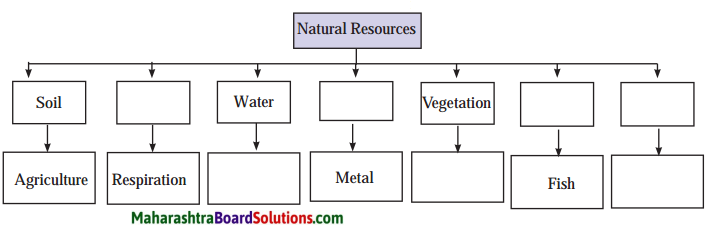
Answer:

C. Answer the following questions:
Question 1.
What factors influence the formation of soil?
Answer:
The formation of soil mainly depends on the original rock, climate, organic components, slope of the land and time.
![]()
Question 2.
Which products are obtained from forests?
Answer:
We obtain products like wood, rubber, resin, fruits, medicinal plants, etc. from forests.
Question 3.
What are the uses of minerals?
Answer:
Metallic minerals are used for obtaining different metals such as iron, bauxite, etc. and non-metallic minerals are used in obtaining various chemicals like gypsum, rock salt, calcite, etc.
Question 4.
What are the purposes for which land is used?
Answer:
- Living things that are bom on land, grow, live and die on land itself.
- Construction and trade are some other purposes for which land is used.
Question 5.
Why are various living things found on the land in different proportions?
Answer:
Depending on the characteristics of land and climate, various living things are found on land in different proportions.
Activity:
Collect the pictures of and information about the sources of freshwater.
Class 6 Geography Chapter 8 Natural Resources Textbook Questions and Answers
Can you tell?
Observe the picture given in figure 8.1. and answer the following question.
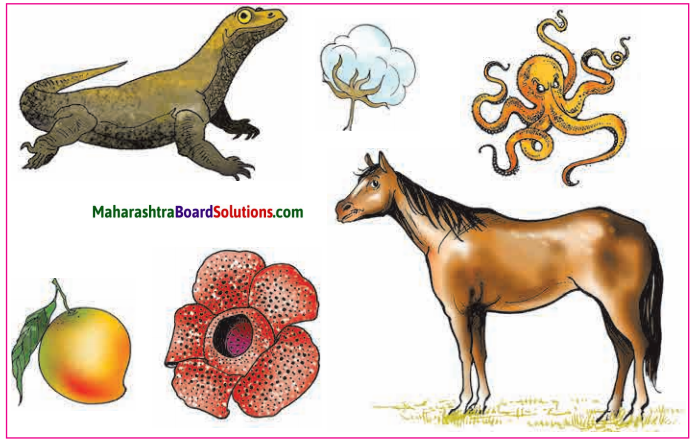
Question 1.
What do you see in the pictures?
Answer:
I can see different animals and plants in the given pictuers.
![]()
Question 2.
How many of these animals or plants do you know?
Answer:
I know all these animals and plants in the given picture.
Question 3.
Which of these things have you seen in reality?
Answer:
I have seen all the cotton ball, mango and horse in reality.
Question 4.
Have you ever used these things or seen them being used?
Answer:
Yes, I have.
Question 5.
Which of our needs do some of these fulfill?
Answer:
- Horse is used in transportation
- Mango is a fruit we eat from
- Cotton is used to make cloth.
Question 6.
What probable use of the unused things can you think of?
Answer:
- Octopus can be kept in aquarium
- Lizards can be kept in the gardens to eat tiny insects.
Observe all the figures and discuss them in the class:
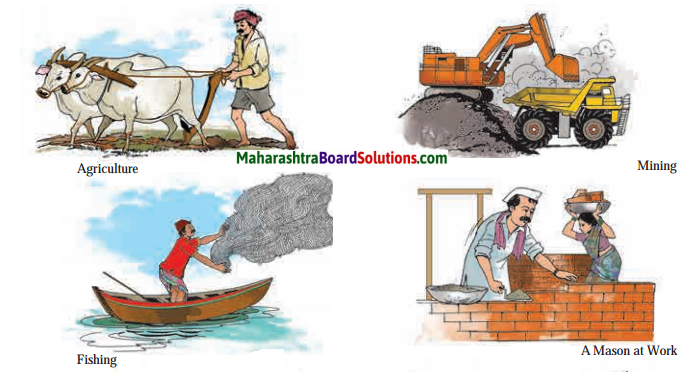
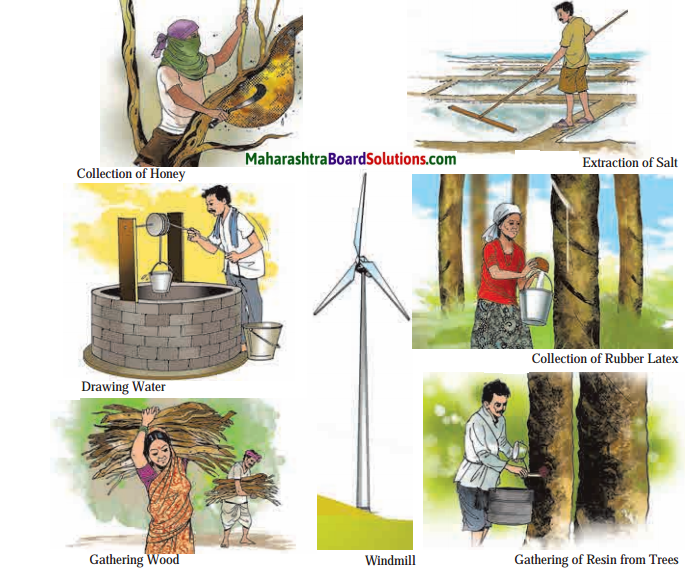
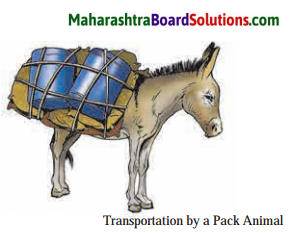
Can you tell?
Question 1.
What different activities are the individuals in the pictures engaged in?
Answer:
The different activities that the individuals in ; the pictures are engaged in are: agriculture, ; fishing, collection of honey, drawing water, ! gathering wood, mining, masonry, extraction i of salt, collection of rubber latex, gathering of resin from trees, converting wind into usable energy, transportation by pack animals.
Question 2.
What things will they obtain through these activities?
Answer:
They will obtain foodgrains, fish, honey, water, wood, minerals, house to live, salt, rubber, resin and energy which can be used for various purposes.
![]()
Question 3.
What are the animals in the picture doing?
Answer:
While the bullocks are ploughing the fields, j the donkey is used as a pack animal, for transporting heavy loads.
Question 4.
What is the use of the tall device in figure 8.12 raised on the ground?
Answer:
The tall device is a windmill which converts i wind into usable energy through the rotation ; of wheel which are adjustable. The energy thus i created can be used for a variety of purposes I such as generating electricity, grinding grains or spices, pumping water, sawing wood, aerating ponds, etc.
Question 5.
What is being loaded in the truck? What are we going to get from it?
Answer:
is being loaded into a truck from the mining area. We get minerals from the same.
Question 6.
Where are all these human activities being performed other than fishing?
Answer:
All these human activities are being performed on land.
Think a little!
Question 1.
List the various things for which we use water. Identify the things that lead to wastage of water.
Answer:
(a) Use of water.
- For agricultural and industrial purposes.
- For drinking and cooking.
- For personal hygiene.
- For our pets.
- Washing clothes and utensils.
- Cleaning houses, vehicles, etc.
- Watering plants in the garden.
(b) Identify the things that leads to wastage of water.
- When we pollute water.
- When we don’t save water by building dams, water wells and irrigation systems.
- When we waste water by using it excessively in flushes, bathrooms, etc.
- When we don’t use water-efficient faucets (taps), showers, etc.
- When we don’t repair faulty faucets.
- When we don’t close the tap when not required.
- When we use fountains and sprinklers in the gardens.
Question 2.
Name the different metals from which the things in your house are made. Make a chart of things and metals.
Answer:
| Things | Metals |
| Cupboard | Stainless steel |
| Furniture | Iron |
| Idols of worship | Bronze |
| Lantern | Silver |
| Electrical wiring | Copper |
| Utensils | Copper and steel |
![]()
Question 3.
List the occupations carried out on land.
Answer:
- Farming.
- Mining.
- Lumbering (Cutting down of trees).
- Extraction such as salt extraction, etc.
- Construction
- Beekeeping, etc.
Observe figure (Textbook Page no. 48) and answer the following questions:
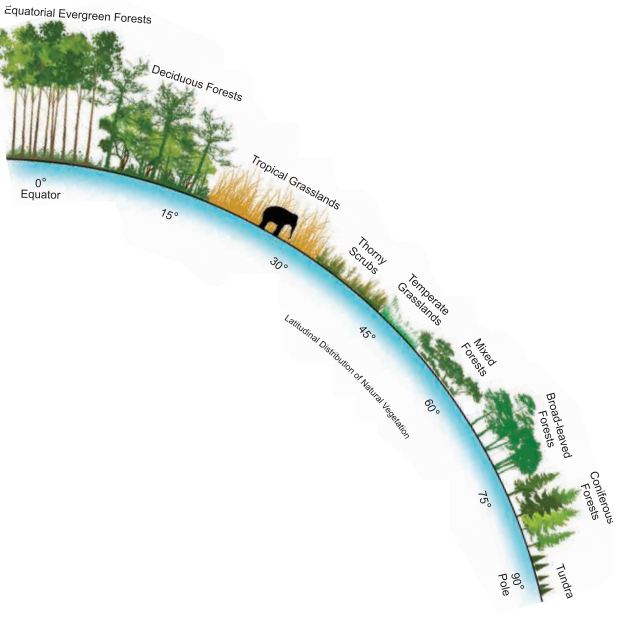
Question 1.
Which vegetations do you find in the following location.
Answer:
| Latitudes | Vegetation |
| (1) 90° Pole | Tundra |
| (2) 0° Equator | Equatorial evergreen |
| (3) 30° | Tropical Grasslands |
| (4) 60° | Mixed Forest |
| (5) 75° – 90° | Coniferous |
| (6) 15° | Deciduous |
Question 2.
In which forest do we find tall trees?
Answer:
Equatorial Evergreen forest.
Question 3.
Name the grassland shown in the picture.
Answer:
Tropical grassland and temperate grassland.
Question 4.
Which vegetation indicate hot deserts?
Answer:
Thorny scrubs
![]()
Class 6 Geography Chapter 8 Natural Resources Textbook Questions and Answers
Complete the following statements using appropriate options:
Question 1.
_____ is a resource which never depletes. (Air, ‘Water, Animals)
Answer:
Air
Question 2.
Formation of mature soil is a very ______ process. (sudden, fast, slow)
Answer:
slow
Question 3.
Rock is a mixture of ________ (stone, black pebbles, minerals)
Answer:
minerals
Question 4.
The proportion of land on earth is ________%.
Answer:
29.20
Question 5.
_______ are the habitats for many animals. (Grassland, Vegetation,Thorny scrubs)
Answer:
Grassland
Match the pairs correctly:
Question 1.
| Column A | Column B |
| (1) Horses and oxens | (a) used for hauling logs |
| (2) Cows and buffaloes | (b) transportation of goods |
| (3) Water available on the earth for use | (c) milk animals |
| (4) Settlements flourished | (d) 0.003% |
| (e) Huang He |
Answer:
1 – b
2 – c
3 – d
4 – e
Name the following:
Question 1.
The natural things that man uses:
Answer:
Natural resources.
Question 2.
A resource that is available in plenty:
Answer:
Air.
![]()
Question 3.
The basins along which man began to live a settled life in the past:
Answer:
- Huang He
- Sindhu (Indus)
- Nile and Euphrates
Question 4.
Habitats of animals:
Answer:
Forest or grasslands.
Question 5.
Any two products we get from animals:
Answer:
- Meat
- Eggs
Question 6.
Metallic minerals used for obtaining different metals:
Answer:
- Iron
- Bauxite
Question 7.
Non-metallic minerals used in obtaining various chemicals:
Answer:
- Gypsum
- Rock salt
- Calcite
![]()
Answer the following questions in one sentence each:
Question 1.
Why are natural resources invaluable?
Answer:
Most of the natural resources are limited in nature and therefore they are invaluable.
Question 2.
What do we need air for?
Answer:
We need air for various purposes right from breathing to burning.
Question 3.
Why do the farmers plough the soil?
Answer:
The farmers plough the soil to make the land cultivable.
Question 4.
How are plants classified?
Answer:
Plants are broadly classified into grass, shrubs and trees.
Give geographical reasons for the following statements:
Question 1.
Soil is a very important resource for agriculture.
Answer:
- The farmer ploughs the soil and makes the land cultivable.
- In this cultivable land, he grows various crops and fulfills his own and other’s need for food.
- For this purpose, he uses the ‘soil’ that is naturally available on land as a resource.
- Therefore soil is very important resource of agriculture.
Question 2.
Man began to live a settled life.
Answer:
- Man has successfully experimented with some grasses to obtain food grains.
- This helped him to avoid painful wandering for gathering food.
- Therefore, man began to lead a settled life.
Question 3.
It is necessary to conserve the natural resources.
Answer:
- Every living thing makes use of natural resources according to its need.
- However, man started using many of these resources for himself alone with the help of his intellectual power.
- Later, the increase in population and the greed of humans led to exploitative use of resources.
- This began to upset the balance in nature.
- So, it is necessary that man also must use the natural resources only according to his need, that is judiciously and thus conserve the natural resources.
Question 4.
Land is an invaluable resource.
Answer:
- All the activities of obtaining natural resources are being carried out on land.
- Land obtained at strategic location is used for construction as well as trade.
- Hence, land is an invaluable resource.
![]()
Answer the following questions in short:
Question 1.
Why are various living things found on the land in different proportions?
Answer:
Depending on the characteristics of land and climate, various living things are found on land in different proportions.
Question 2.
Which are the various geographical conditions which all living things try to adapt to?
Answer:
All living things try to adapt to various geographical conditions like rocky terrain, steep slopes, flat plains, mountainous regions, forest-covered areas, river basin, etc.